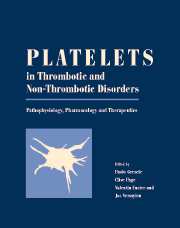Book contents
- Frontmatter
- Contents
- List of contributors
- Editors' preface
- PART I PHYSIOLOGY
- PART II METHODOLOGY
- PART III PATHOLOGY
- 34 Hereditary thrombocytopenias
- 35 Thrombocytopenias due to bone marrow disorders
- 36 Immune-mediated thrombocytopenia
- 37 Thrombocytopenia in childhood
- 38 Alloimmune thrombocytopenia
- 39 Drug-induced and drug-dependent immune thrombocytopenias
- 40 Thrombotic thrombocytopenic purpura and hemolytic uremic syndrome
- 41 Thrombocytosis and thrombocythemia
- 42 Platelet adhesive protein defect disorders
- 43 Congenital disorders of platelet secretion
- 44 Congenital platelet signal transduction defects
- 45 Acquired platelet function defects
- 46 Platelet storage and transfusion
- 47 Pathophysiology of arterial thrombosis
- 48 Platelets and atherosclerosis
- 49 Platelet involvement in venous thrombosis and pulmonary embolism
- 50 Gene regulation of platelet function
- 51 Platelets and bacterial infections
- 52 Interactions of viruses and platelets and the inactivation of viruses in platelet concentrates prepared for transfusion
- 53 Platelets and parasites
- 54 Platelets and tumours
- 55 Platelets and renal diseases
- 56 Platelets and allergic diseases
- 57 Platelet interactions with other cells related to inflammatory diseases
- 58 Platelets and the preimplantation stage of embryo development
- 59 Platelets in psychiatric and neurological disorders
- 60 Platelets in inflammatory bowel disease
- PART IV PHARMOLOGY
- PART V THERAPY
- Afterword: Platelets: a personal story
- Index
- Plate section
42 - Platelet adhesive protein defect disorders
from PART III - PATHOLOGY
Published online by Cambridge University Press: 10 May 2010
- Frontmatter
- Contents
- List of contributors
- Editors' preface
- PART I PHYSIOLOGY
- PART II METHODOLOGY
- PART III PATHOLOGY
- 34 Hereditary thrombocytopenias
- 35 Thrombocytopenias due to bone marrow disorders
- 36 Immune-mediated thrombocytopenia
- 37 Thrombocytopenia in childhood
- 38 Alloimmune thrombocytopenia
- 39 Drug-induced and drug-dependent immune thrombocytopenias
- 40 Thrombotic thrombocytopenic purpura and hemolytic uremic syndrome
- 41 Thrombocytosis and thrombocythemia
- 42 Platelet adhesive protein defect disorders
- 43 Congenital disorders of platelet secretion
- 44 Congenital platelet signal transduction defects
- 45 Acquired platelet function defects
- 46 Platelet storage and transfusion
- 47 Pathophysiology of arterial thrombosis
- 48 Platelets and atherosclerosis
- 49 Platelet involvement in venous thrombosis and pulmonary embolism
- 50 Gene regulation of platelet function
- 51 Platelets and bacterial infections
- 52 Interactions of viruses and platelets and the inactivation of viruses in platelet concentrates prepared for transfusion
- 53 Platelets and parasites
- 54 Platelets and tumours
- 55 Platelets and renal diseases
- 56 Platelets and allergic diseases
- 57 Platelet interactions with other cells related to inflammatory diseases
- 58 Platelets and the preimplantation stage of embryo development
- 59 Platelets in psychiatric and neurological disorders
- 60 Platelets in inflammatory bowel disease
- PART IV PHARMOLOGY
- PART V THERAPY
- Afterword: Platelets: a personal story
- Index
- Plate section
Summary
Introduction
The investigation of platelet defects causing bleeding disorders has been an important step in determining the roles of the major glycoproteins in platelet function. In particular, Bernard–Soulier syndrome and Glanzmann's thrombasthenia have provided the basis for studying the function of the GPIb complex and αIIbβ3, respectively. More recently, some generally milder bleeding disorders have been related to the absence or deficiency of other platelet receptors. With the development of techniques to produce mice in which specific gene expression has been deleted, these defects can also be reproduced and can be corrected by gene therapy. Have the disorders in humans still lessons to teach us? Probably the main diseases have already been discovered but we cannot exclude that a detailed screening of patients with mild, platelet related, bleeding disorders might disclose defects in previously unknown minor platelet receptors or new mutations with different effects in known receptors. Many patients with mild bleeding problems related to platelets are seen in hematology departments and cannot yet be diagnosed at a molecular level. Achieving the ability to diagnose the defects in these patients is still a major goal in platelet studies and may be amenable to proteomics approaches. Until X-ray crystallographic structures are available for the GPIb complex and αIIbβ3, information provided by the molecular diagnosis of Bernard–Soulier syndrome and Glanzmann's thrombasthenia will continue to provide important data on structure– functional relationships.
- Type
- Chapter
- Information
- Platelets in Thrombotic and Non-Thrombotic DisordersPathophysiology, Pharmacology and Therapeutics, pp. 639 - 654Publisher: Cambridge University PressPrint publication year: 2002
- 1
- Cited by



